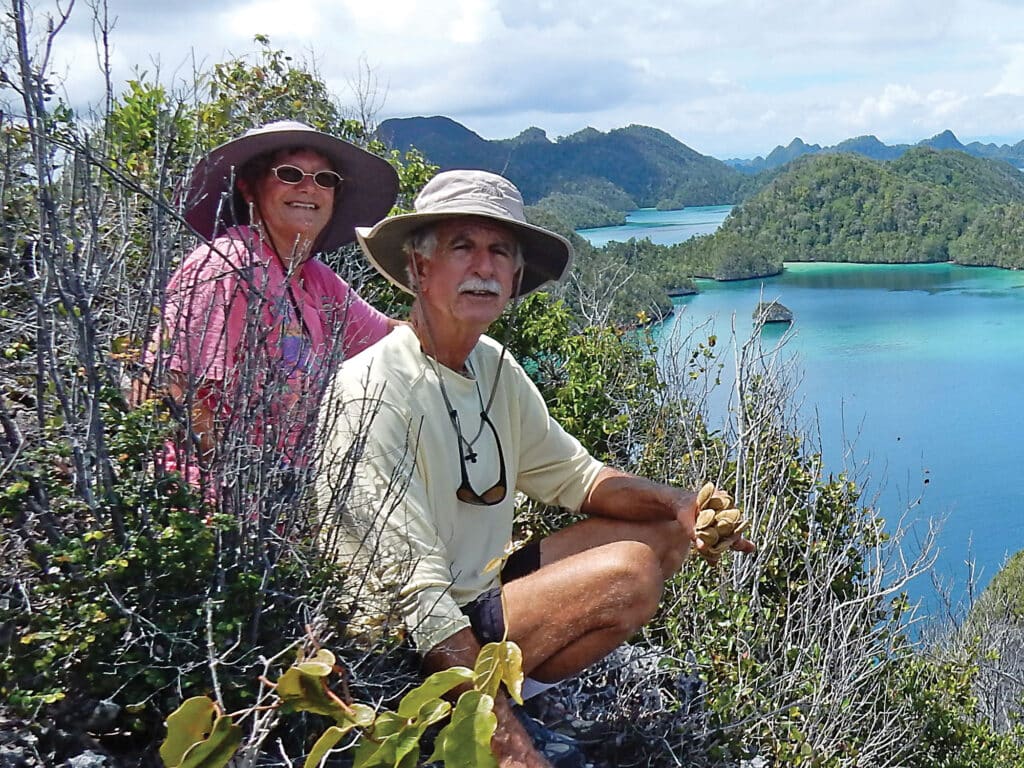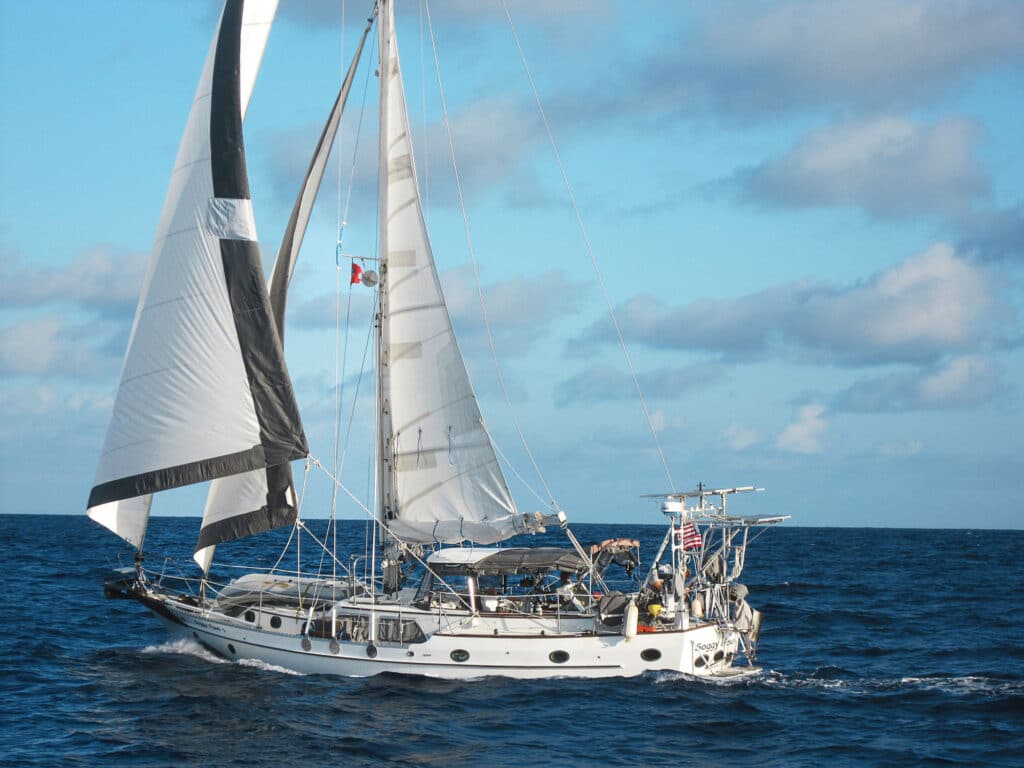
Their numbers are impressive: 45,000 miles, a couple dozen countries, islands too many to count, and 16 years with five to go before sailing completely around the world. A life’s accomplishment by any measure, with enough stories and pictures to fill a closetful of magazines.
But when Sherry and Dave McCampbell talk about circumnavigating, what you more often hear is nitty-gritty — “all the mundane stuff for our visits anywhere to be fun and stress-free,” Sherry says. “If you don’t sweat the small stuff, it doesn’t get done.”
Dave adds: “We plan ahead a lot. There are cruisers who say, ‘Oh, we just go.’ But I think you miss a lot if you do that. You end up in the wrong place, the wrong season, you get hit by weather that you wouldn’t if you were just watching what was going on. We have our next year planned out. We know where we’re going, pretty much. We know what the route is, we know when to go, and all of that.”
Sailing the world is not cruising the Virgin Islands. It takes years. It takes a good boat. It takes money. “It takes somebody who knows the boat and can make repairs in out-of-the-way places,” Dave says. “You can’t get too seasick. You can’t get too scared of being a thousand miles from shore. You can’t have a lot of family issues back home.”
Stir in a thirst for adventure and compatibility, and you’ve got the McCampbells. Which explains why the Florida pair will likely join the rather exclusive club of cruisers who have circumnavigated.
Dave, 77, a former US Navy diver, hatched the dream and acquired the boat in 1996. It was a beat-up 1980 CSY 44 Walkthrough Cutter for sale at $65,000. It had been chartered for 20 years, was in “horrible” shape, and needed 10 years to replace virtually everything to cross the Pacific. He named the boat Soggy Paws for a cat that dipped its foot while drinking water.
Sherry, 66, whose US Navy father took his family on a yearlong Caribbean cruise the year she graduated from high school, later led a women’s race team while programming computers and looking for a partner with a well-equipped boat for long-distance cruising. “I dated a few guys who said they were sailors, but they were dock people,” she says.
Theirs was a quick courtship. They met March 5, 2006, sailed together on May 19, and on June 25, Dave asked her if she would go around the world with him. After working through a neatness divide, they married in 2007 and took off. “About once a month, we invite some people over,” Dave says with a chuckle. “That ends up being a mad scramble to clean up the boat. That works for me.”
As of this writing, they are docked in Malaysia. They make an annual trip home to see family and friends, pick up boat parts, get medical and dental checkups, and take a break from the small floating worlds they’ve occupied 24/7 for 16 years. In 2015, they enlarged their world by buying a St. Francis 44 catamaran, paid for with the sale of the CSY and $100,000 that Dave inherited.
The monohull was, by then, 45 years old and becoming a maintenance black hole. After sailing on a catamaran, they came to admire sailing flat, with a heel of less than 5 degrees—“a huge advantage because you don’t get anywhere near as tired,” Dave says. “When underway, I can do things that I never could before: work on a computer, relax. The equipment is much more modern. It goes faster. It has so much more room for the stuff we’ve got.”
They transferred the name; furnished a watermaker and refrigerator/freezer; upgraded the electric system (powered by solar panels), saildrives and interior lighting; and extended the hulls at the stern to create a dive platform. They’ve made hundreds of dives in their years afloat.
With her computer and communications skills, Sherry has compiled an online circumnavigation encyclopedia that details virtually every aspect of what they’ve learned. The site has neatly organized “compendiums” with indexes by year, by country, by task. There are 82 “maintenance” entries, 53 under “Indonesia,” and several dozen “passages.” From entry procedures to pirate precautions to how to make wine from rice in Muslim countries to historic World War II battle sites (Dave’s father, David, was a flying ace and Medal of Honor winner), their site is a day-to-day, sometimes hourly, account of what it’s been like to sail halfway around the world. The site has received half a million views.

The high points for them were long, slow island hopping in Micronesia and Fiji, the first with few other cruisers, the second with an active social net. “I used to fall asleep in geography class,” Sherry admits. “But now I’m discovering geography one country at a time, one person at a time. We’ve tried to learn about 10 different languages.”
The lows were slogging passages, upwind, against a current, in midsquall: wet memories that, with time, lose their edge. Oh, and that time on route to the Solomons when one of their engines died.
With good retirement plans that have actually increased in value, the McCampbells have also been able to park their boat and travel to other countries by air. Coming home to Florida has been a culture shock, in terms of politics and wealth. “This crazy United States isn’t where we left,” is all Sherry wanted to say for the record.
Their view of the world has also changed. “There are little things that we had no idea about,” Dave says. “The number of people who are living just fine with no money at all in some of these out islands. They’re able to survive, do their own fishing and farming with essentially no income, just barely getting by but still having a good time, smiling and very welcoming to us.”
As members of the Seven Seas Cruising Association, they carry a tub of supplies to trade or give away. Sherry’s first impulse to carry lipsticks and makeup was welcomed in French Polynesia but not in the Solomons. “They want fishing gear, T-shirts, towels, soap, things for their kids: pens, pencils, paper, stuff they could use,” Dave says. And eyeglasses. Inexpensive drugstore magnifiers. Anybody over 40, because of the sun, had cataracts and wanted glasses.
If their good health holds, Dave and Sherry plan to head for the Mediterranean this December, up through the Red Sea. According to their current plan, by the time they finally get home, 20 years will have elapsed.
“One of our worries is, we’ve been out 16 years and we’re still only about halfway around, and we need to get the rest of the way around before one of us croaks,” Dave says.
Sherry adds: “We’re still alive. We’re still having adventures at our age.”
Jim Carrier taught himself to sail on Long Island Sound in a $100 Snark he carried atop his Mustang. After it blew apart in a million foam beads on I-95, he bought a 1970 Allied Seabreeze yawl and sailed it 15,000 miles across the Atlantic and Mediterranean.








